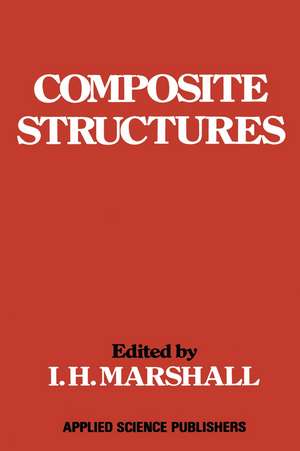Composite Structures
Editat de I. H. Marshallen Limba Engleză Paperback – 11 noi 2011
| Toate formatele și edițiile | Preț | Express |
|---|---|---|
| Paperback (1) | 411.80 lei 6-8 săpt. | |
| SPRINGER NETHERLANDS – 11 noi 2011 | 411.80 lei 6-8 săpt. | |
| Hardback (1) | 431.24 lei 6-8 săpt. | |
| SPRINGER NETHERLANDS – 30 sep 1991 | 431.24 lei 6-8 săpt. |
Preț: 411.80 lei
Nou
Puncte Express: 618
Preț estimativ în valută:
78.80€ • 82.27$ • 65.22£
78.80€ • 82.27$ • 65.22£
Carte tipărită la comandă
Livrare economică 04-18 aprilie
Preluare comenzi: 021 569.72.76
Specificații
ISBN-13: 9789400981225
ISBN-10: 9400981228
Pagini: 744
Ilustrații: XVI, 722 p.
Dimensiuni: 152 x 229 x 39 mm
Greutate: 0.98 kg
Ediția:Softcover reprint of the original 1st ed. 1981
Editura: SPRINGER NETHERLANDS
Colecția Springer
Locul publicării:Dordrecht, Netherlands
ISBN-10: 9400981228
Pagini: 744
Ilustrații: XVI, 722 p.
Dimensiuni: 152 x 229 x 39 mm
Greutate: 0.98 kg
Ediția:Softcover reprint of the original 1st ed. 1981
Editura: SPRINGER NETHERLANDS
Colecția Springer
Locul publicării:Dordrecht, Netherlands
Public țintă
ResearchCuprins
Session I: Plenary.- 1. Composite Materials Education in the United States.- 2. Engineering Plastics—Some Factors Affecting Technology Transfer.- Session II: Bolted Connections.- 3. Analysis of the Shearout Failure Mode in Composite Bolted Joints.- 4. Stress and Strength Analysis of Bolted Joints in Composite Laminates.- 5. Some Environmental and Geometric Effects on the Static Strength of Graphite Cloth Epoxy Bolted Joints.- Session III: Environmental Effects.- 6. The Stress-Rupture Behaviour of GRP Laminates in Aqueous Environments.- 7. Water Absorption by Glass Fibre Reinforced Epoxy Resin.- 8. Failure of GRP in Corrosive Environments.- Session IV: Research and Development: Analytical Studies.- 9. Large Deflection Analysis of Bimodular Cross-Ply Strips ….- 10. Analysis of Thermally Stressed Variable Thickness Composite Discs—a CAD Technique.- 11. Optimization of Laminated Shells with Multiple Loading Conditions and Fabrication Constraints.- Session V: Research and Development: Marine Applications.- 12. Recent Developments in Polyester Matrices and Reinforcements for Marine Applications, in Particular Polyester/ Kevlar Composites.- 13. The Testing and Analysis of Novel Top-Hat Stiffener Fabrication Methods for use in GRP Ships.- 14. The Development of Improved FRP Laminates for Ship Hull Construction.- Session VI: Research and Development: Modelling Techniques.- 15. Development of Cylindrically Orthotropic Model Material for Transmission Photoelasticity.- 16. Photoelastic Techniques for the Complete Determination of Stresses in Composite Structures.- 17. A Boundary Layer Approach to the Calculation of Transverse Stresses Along the Free Edges of a Symmetric Laminated Plate of Arbitrary Width Under In-Plane Loading.- Session VII: Physical and MechanicalCharacteristics (1).- 18. On the Orthotropic Elastic Behaviour of a Rubber Composite.- 19. The Viscoelastic Response of a Graphite/Epoxy Laminate.- 20. Viscoelastic Properties of Composite Materials.- Session VIII: Structural Analysis: Platework Systems.- 21. Advances in Vibration, Buckling and Postbuckling Studies on Composite Plates.- 22. On the Use of the Effective Width Concept for Composite Plates.- 23. Unsymmetrical Buckling of Laterally Loaded, Thin, Initially Imperfect Orthotropic Plates.- Session IX: Structural Analysis: Structural Systems.- 24. The Effect of Mode Interaction in Orthotropic Fibre Reinforced Composite Plain Channel Section Columns.- 25. The Stability Analysis of a Continuum/Skeletal Fibre Matrix System.- 26. The Postbuckling Behaviour of Composite Box Sections ….- Session X: Physical and Mechanical Characteristics (2).- 27. The Effect of Thermal Strains on the Microcracking and Stress Corrosion Behaviour of GRP.- 28. Electrically Conductive Prepreg Systems.- Session XI: Structural Evaluation Techniques.- 29. Analysis of Composite Materials by Dynamic Thermomechanometry (Dynamic Mechanical Analysis).- 30. Evaluation of Composite Structures by Stress-Wave-Factor and Acoustic Emission.- 31. Vibration Testing of Composite Materials.- Session XII: Design.- 32. A Minimum Energy Composite Automobile.- 33. Structures in Reinforced Composites.- 34. Properties and Performance of GRC.- Session XIII: Experimental Studies.- 35. Buckling of Platestrips—An Evaluation of Six Carbon-Epoxy Laminates.- 36. The Damage Tolerance of High Performance Composites.- 37. Tensile Fatigue Assessment of Candidate Resins for Use in Fibre Reinforced Composite Repair Schemes.- 38. Temperature Increase in SMC Fatigue Testing.- Session XIV: Fabrication Studies includingNatural Fibre Composites.- 39. A Unique Approach to Fabricating Precision Space Structures Elements.- 40. Manufacturing Methods for Carbon Fiber/Polyimide Matrix Composites.- 41. The Use of Natural Organic Fibres in Cement: Some Structural Considerations.- 42. On the Possibility of Using Natural Fibre Composites.- Session XV: Fracture and Failure Analysis.- 43. Stress Intensity Factor Measurements in Composite Sandwich Structures.- 44. Progressive Failure Model for Advanced Composite Laminates Containing a Circular Hole.- Session XVI: Research and Development: Analysis of Laminated Structures.- 45. Nonlinear Response of Angle-Ply Laminated Plates to Random Loads.- Session XVII: Physical and Mechanical Characteristics (3).- 46. Effects of Elastomeric Additives on the Mechanical Properties of Epoxy Resin and Composite Systems.- Session XVIII: Finite Element Studies.- 47. A Comparison of the Failure Pressure as Predicted by Finite Element Stress Analysis with the Results of Full Scale Burst Tests on GRP Flanges.- 48. Elastic-Plastic Flexural Analysis of Laminated Composite Plates by the Finite Element Method.
